

The Swastika
Dispersion of the Swastika
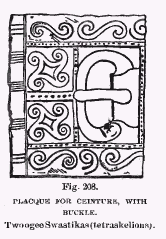
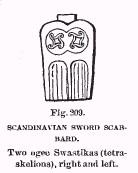

scabbards. In fig. 208 is shown a placque for a ceinture or belt, with a buckle to receive the thong. It contains two ogee Swastikas (tetraskelions). In this and fig. 207 the border and accessory decoration consist largely of ogee curves, which, here represented separate, would, if placed together as a cross, form the same style of Swastika as those mentioned. Figs. 209 and 210 show sword scabbards, with Swastikas turned both ways. Fig. 211 shows two triskelions. Fig. 212
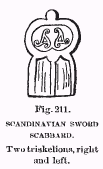 represents
a gold brooch from a grave at Fyen, reported by Worsaae and figured by
Waring. (1) The brooch with
ogee Swastika bears internal evidence of Scandinavian workmanship. There
are other Swastikas of the same general form and style in distant localities,
and this specimen serves to emphasize the extent of possible communication
between distant peoples in prehistoric times. Fig. 213 represents a piece
of horse-gear of bronze, silver plated and ornamented with Swastikas.
Two of these are normal, the ends bent at right angles to the left, while
the other is fancifully made, the only specimen yet found of that pattern.
(2) It is not seen that these
fanciful additions serve any purpose other than decoration. They do not
appear to have changed the symbolic meaning of the Swastika. Fig. 214
represents a sword scabbard belonging
represents
a gold brooch from a grave at Fyen, reported by Worsaae and figured by
Waring. (1) The brooch with
ogee Swastika bears internal evidence of Scandinavian workmanship. There
are other Swastikas of the same general form and style in distant localities,
and this specimen serves to emphasize the extent of possible communication
between distant peoples in prehistoric times. Fig. 213 represents a piece
of horse-gear of bronze, silver plated and ornamented with Swastikas.
Two of these are normal, the ends bent at right angles to the left, while
the other is fancifully made, the only specimen yet found of that pattern.
(2) It is not seen that these
fanciful additions serve any purpose other than decoration. They do not
appear to have changed the symbolic meaning of the Swastika. Fig. 214
represents a sword scabbard belonging 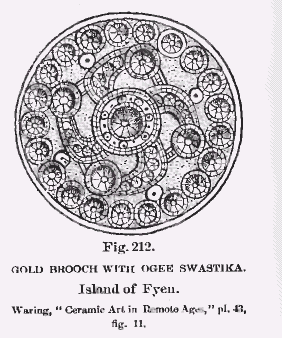 to
the Vimose find, with a normal Swastika. Ludwig Müller reproduces
a Swastika cross from a runic stone in Sweden. In an ancient church in
Denmark, the baptismal font is decorated with Swastikas, showing its use
in early Christian times. (See p. 878 for continuation of Swastika on
Scandinavian or Danish gold bracteates.)
to
the Vimose find, with a normal Swastika. Ludwig Müller reproduces
a Swastika cross from a runic stone in Sweden. In an ancient church in
Denmark, the baptismal font is decorated with Swastikas, showing its use
in early Christian times. (See p. 878 for continuation of Swastika on
Scandinavian or Danish gold bracteates.)Mr. Paul du Chaillu, in his "Viking Age," mentions many specimens of Scandinavian and Norse antiquities bearing Swastika marks of diverse styles: Bronze vessels (vol. 1, p. 100, note 1); iron spear point with runes and Swastika inlaid with silver, discovered in a tumulus with burnt bones, Mucheburg, fig. 336; another of the same, Volhynia, Russia, fig. 337; pottery vessel containing burnt bones, pointed iron knife, bronze needle, and melted glass beads, Bornholm, fig. 210; iron spearhead, Vimose bog find, (p. 207); border of finely woven silk cloth with gold and silver threads, from a mound (vol. 2, p. 289, fig. 1150).
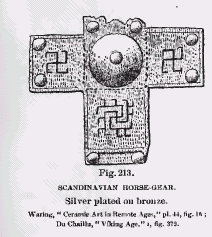 Scotland and Ireland. --- Specimens
of the Swastika have been found on the Ogam stones in Scotland and Ireland
(p. 797). In the churchyard of Aglish, county Kerry, Ireland, stand two
stones bearing Ogam inscriptions. At the top of one is an ancient Celtic
cross enclosed in a circle similar to figs.
7; immediately under it are two Swastika marks of four arms crossing
at right angles, each arm bent to the right also a at right angles. On
two corners of the stone are inscriptions of the usual Ogam characters.
The translation may be given, but seems to be unimportant and without
apparent bearing upon this question. They are somewhat obliterated and
their reading difficult. So far as made out they are as follows: Maqimaqa
and Apiloggo.
Scotland and Ireland. --- Specimens
of the Swastika have been found on the Ogam stones in Scotland and Ireland
(p. 797). In the churchyard of Aglish, county Kerry, Ireland, stand two
stones bearing Ogam inscriptions. At the top of one is an ancient Celtic
cross enclosed in a circle similar to figs.
7; immediately under it are two Swastika marks of four arms crossing
at right angles, each arm bent to the right also a at right angles. On
two corners of the stone are inscriptions of the usual Ogam characters.
The translation may be given, but seems to be unimportant and without
apparent bearing upon this question. They are somewhat obliterated and
their reading difficult. So far as made out they are as follows: Maqimaqa
and Apiloggo.In Scotland, the Newton stone, in the grounds of the Newton House, bears an Ogam inscription, the meaning of which has no bearing upon

ENDNOTES:
1. "Ceramic Art in Remote Ages," pl. 43, fig. 11; "Viking Age," II, fig. 1311; Englehardt, "L'Ancien Age de Fer," fig. 28. [Back]
2. Du Chaillu, "Viking Age," I, fig. 379. Back
<< Previous Page Next Page >>
© 2004-2007 Northvegr.
Most of the material on this site is in the public domain. However, many people have worked very hard to bring these texts to you so if you do use the work, we would appreciate it if you could give credit to both the Northvegr site and to the individuals who worked to bring you these texts. A small number of texts are copyrighted and cannot be used without the author's permission. Any text that is copyrighted will have a clear notation of such on the main index page for that text. Inquiries can be sent to info@northvegr.org. Northvegr™ and the Northvegr symbol are trademarks and service marks of the Northvegr Foundation.

|